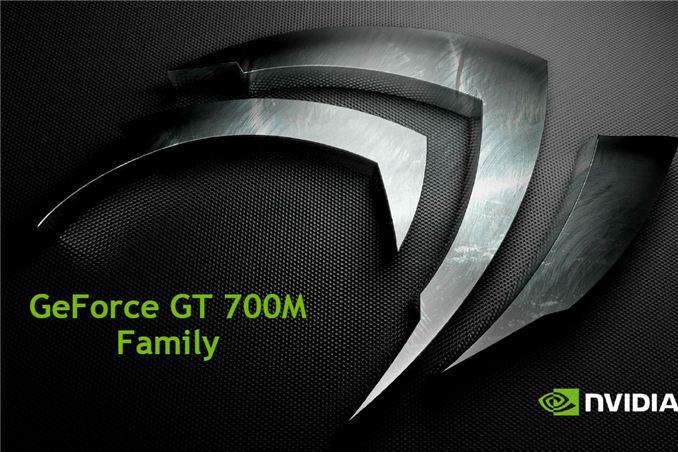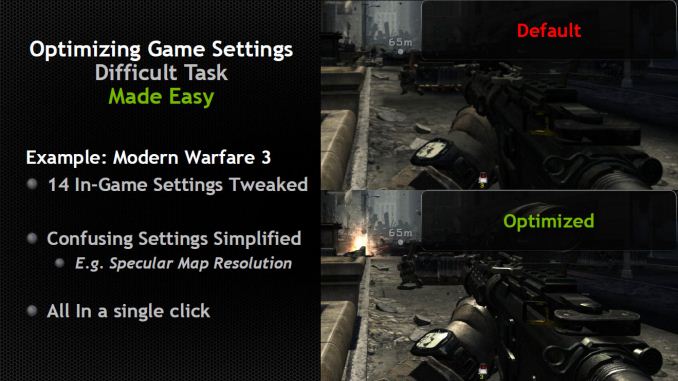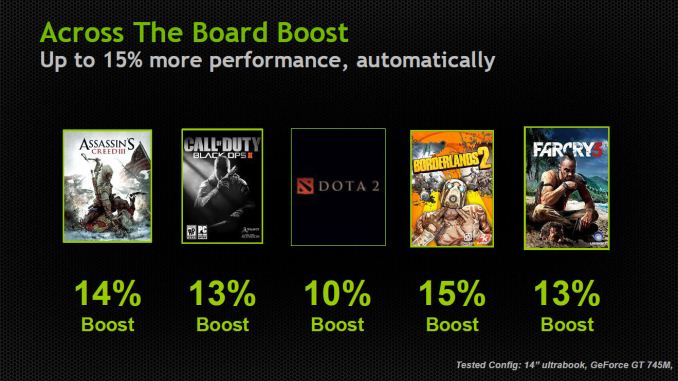NVIDIA’s GeForce 700M Family: Full Details and Specs
by Jarred Walton on April 1, 2013 9:00 AM EST
Introducing the NVIDIA GeForce 700M Family
With spring now well under way and the pending launch of Intel’s Haswell chips, OEMs always like to have “new” parts across the board, and so once more we’re getting a new series of chips from NVIDIA, the 700M parts. We’ve already seen a few laptops shipping with the 710M and GT 730M; today NVIDIA is filling out the rest of 700M family. Last year saw NVIDIA’s very successful launch of mobile Kepler; since that time, the number of laptops shipping with NVIDIA dGPUs compared to AMD dGPUs appears to have shifted even more in NVIDIA’s favor.
Not surprisingly, with TSMC still on 28nm NVIDIA isn’t launching a new architecture, but they’ll be tweaking Kepler to keep it going through 2013. Today's launch of the various 700M GPUs is thus very similar to what we saw with the 500M launch: everything in general gets a bit faster than the previous generation. To improve Kepler NVIDIA is taking the existing architecture and making a few moderate tweaks, improving their drivers (which will also apply to existing GPUs), and as usual they’re continuing to proclaim the advantages of Optimus Technology.
Starting on the software side of things, we don’t really have anything new to add on the Optimus front, other than to say that in our experience it continues to work well on Windows platforms—Linux users may feel otherwise, naturally. On the bright side, things like the Bumblebee Project appear to be helping the situation, so now it's at least possible to utilize the dGPU and iGPU under Linux. As far as OEMs go, Optimus has now matured to the point where I can't immediately come up with any new laptop that has an NVIDIA GPU and doesn't support Optimus; we're now at the point where an NVIDIA equipped laptop inherently implies Optimus support.
The second software aspect is NVIDIA’s GeForce Experience software, which allows for automatic game configuration based on your hardware. You can see the full slide deck in the gallery at the end with a few additional details, but GeForce Experience is a new software tool that’s designed to automatically adjust supported games to the “best quality for your hardware” setting. This may not seem like a big deal for enthusiasts, but for your average Joe that doesn’t know what all the technical names mean (e.g. antialiasing, anisotropic filtering, specular highlighting, etc.) it’s a step towards making PCs more gamer friendly—more like a console experience, only with faster hardware. ;-) GeForce Experience is already in open beta, with over 1.5 million downloads and counting, so it’s definitely something people are using.
Finally, NVIDIA has added GPU Boost 2.0 to the 700M family. This is basically the same as what’s found in GeForce Titan, though with some tuning specific to mobile platforms as opposed to desktops. We’re told GPU Boost 2.0 is the same core hardware as GPU Boost 1.0, with software refinements allowing for more fine-grained control of the clocks. Ryan has already covered GPU Boost 2.0 extensively, so we won’t spend much more time on it other than to say that over a range of titles, NVIDIA is getting a 10-15% performance improvement relative to GPU Boost 1.0.
Moving to the hardware elements, hardware change only applies to one of the chips. GK104 will continue as the highest performing option in the GTX 675MX and GTX 680M (as well as the GTX 680MX in the iMac 27), and GK106 will likewise continue in the GTX 670MX (though it appears some 670MX chips also use GK104). In fact, for now NVIDIA isn’t announcing any new high-end mobile GPUs, so the GTX 600M parts will continue to fill that niche. The changes come for everything in the GT family, with some of the chips apparently continuing to use GK107 while a couple options will utilize a new GK208 part.
While NVIDIA won’t confirm which parts use GK208, the latest drivers do refer to that part number so we know it exists. GK208 looks to be largely the same as GK107, and we’re not sure if there are any real differences other than the fact that GK208 will be available as a 64-bit part. Given the similarity in appearance, it may serve as a 128-bit part as well. Basically, GK107 was never available in a 64-bit configuration, and GK208 remedies that (which actually makes it a lower end chip relative to GK107).













91 Comments
View All Comments
moep - Monday, April 1, 2013 - link
The slide deck does not work (404).Technical difficulty or did you have to pull it?
JarredWalton - Monday, April 1, 2013 - link
It's there now... our gallery is set to post things by day only, and since the NDA was at 9AM Eastern I didn't want the gallery going live nine hours early. So I set it for 4/2 and then just changed it to 4/1.nunomoreira10 - Monday, April 1, 2013 - link
I was hoping to get an 15 inch normal size laptop with a gk106 fully enabled this summer, but this just crushed my hopes.they will just keep using those highly clocked gk107 and call it mid-high end...
JarredWalton - Monday, April 1, 2013 - link
A fully enabled GK106 is almost certainly in the works, but it will be something like a GTX 770M. GTX 780M is likely to be GK104, but it will be interesting to see if NVIDIA can do a full enabled GK104 while keeping it within the typical 100W power envelope that gaming notebooks target. GTX 680MX is a full GK104, but I understand TDP is ~125W or so and that's why the only product using it is the iMac 27. We'll likely see the high-end 700M parts launch in June or July.transphasic - Monday, April 1, 2013 - link
Jared, a question for you regarding the 700m line out this year- are these going to be backwards compatible with our current HM laptops from 2012, or are they only for the new Haswell design?Due to the issues that we have had with AMD, there's quite a few of us that want to get rid of AMD, and upgrade to the newest Nvidia card, and this 780m is quite a bit faster than the 680m.
I would like to swap out my 7970m GPU for the upcoming 780m card, and was wondering if this is do-able or not.
JarredWalton - Monday, April 1, 2013 - link
Keep in mind that I'm guessing at 780M -- I could be off. As for backwards compatibility, given that we're essentially looking at minor tweaks and revisions to Kepler, they should all work fine in existing laptops. Getting a replacement GPU might be a bit difficult/expensive, though. Quick question: did the latest 13.3 beta drivers help you at all with 7970M? I Haven't had a chance to test then yet.transphasic - Monday, April 1, 2013 - link
The new Catalyst 13.3 beta drivers are fine, and have no problems yet with them. My concern, though, is that these last few driver releases from AMD have not/are not dealing with increasing the FPS rates on current games, while Nvidia's has.Even though the new games that are out like Bioshock are AMD-coded, Nvidia is winning the battle on better gaming performance. While Nvidia is releasing their standard (and better) drivers for newer games at a faster rate than AMD is (as is usual), AMD is falling further and futher behind in other areas as well in terms of hardware specs- in this case, their 8000 series gaming GPU for this summer which has been very disappointing in it's specs, to say the least.
This is why I want to upgrade to the new 780m GPU. From what was said on another forum, the preliminary specs for the 780m is the equivalent of the 680MX for the Imac released late last year.
It is said to offer a 20%+ improvement over the 680m, and if it's backwards compatible to the HM series motherboards that we currently have, it's worth thinking about upgrading to this year for our existing Sager laptops.
You're right about the cost, though. If the price is prohibitive, then it would make sense to wait for the Maxwell release next year with whatever Nvidia has out then.
It really depends on cost at this point.
nunomoreira10 - Monday, April 1, 2013 - link
A fully enabled gk106 may be asking to muchmaybe with 1 smx and a 64-bit memory controler disabled
leaving it with 3 smx a fast 128-bit memory controler and call it gt755m or gtx760m
it would be the gt555m of this generation and a sweet spot for a standart perfomance 15 inch laptop.
JarredWalton - Monday, April 1, 2013 - link
I'm about 99% sure we'll see a full GK106 on mobile this year; the only question is what they'll call it. Well, that and how much power will it use and what will its clocks be. For clocks, 2500MHz (5000MHz effective GDDR5) seems likely, and clocks will probably be in the 600-700MHz range with Boost taking it up to a max of around 800MHz. That's my guess anyway. TDP will be ~70W, though, so this will be a part for larger gaming notebooks only./speculation
tviceman - Monday, April 1, 2013 - link
Based on the products announced today, it looks like GK106 based mobile GPU's will start with the gtx760m, and will surely be available in a 15" form factor.